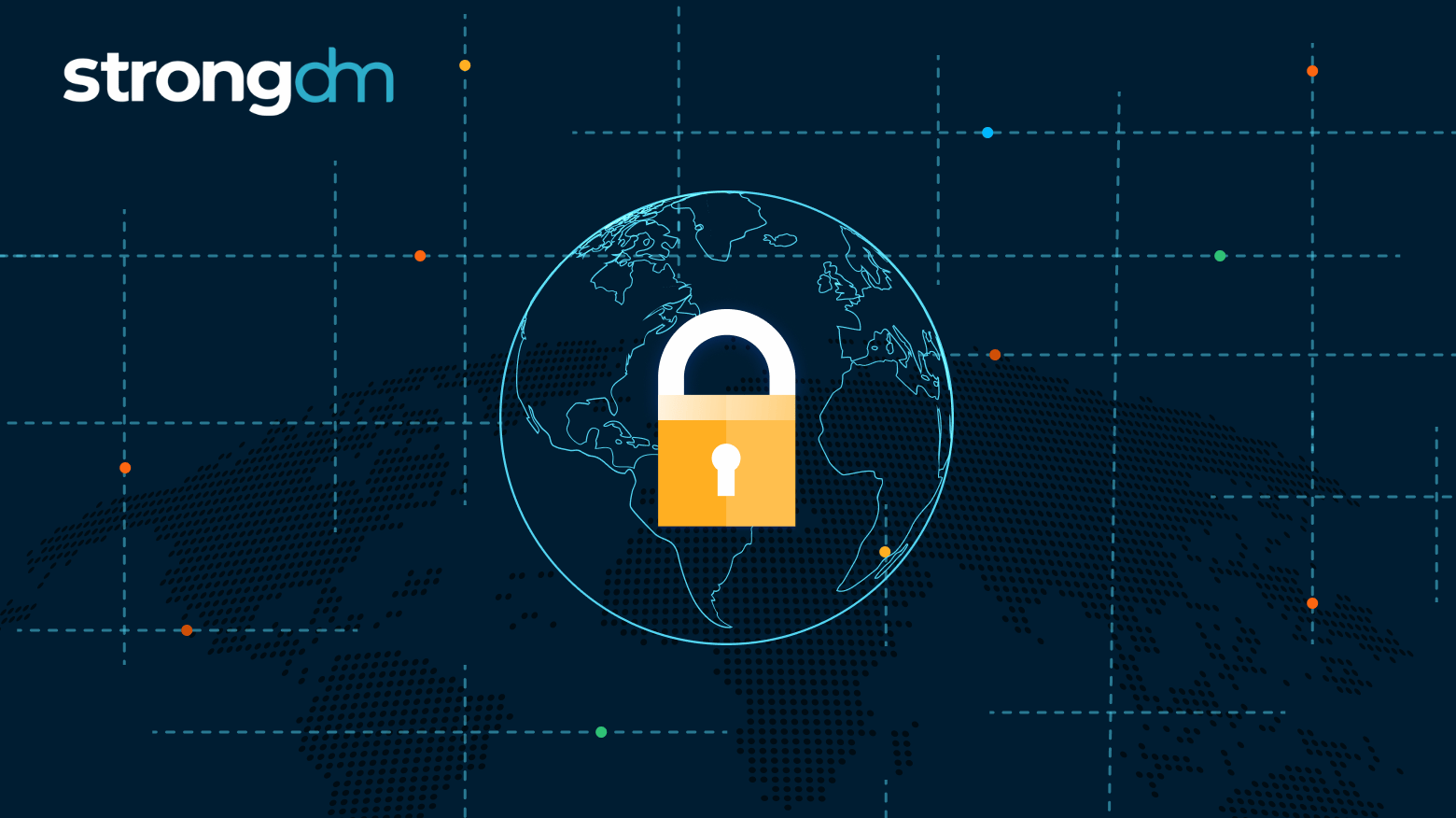Securing Network Devices with StrongDM's Zero Trust PAM Platform

Contents
Built for Security. Loved by Devs.
- Free Trial — No Credit Card Needed
- Full Access to All Features
- Trusted by the Fortune 100, early startups, and everyone in between
Let’s talk about the unsung heroes of your on-premises infrastructure: network devices. These are the routers, switches, and firewalls that everyone forgets about…and takes for granted—until something breaks. And when one of those somethings breaks, it leads to some pretty bad stuff. If your network goes down, that’s bad, bad, bad for business. But if those devices lack the necessary security, well, that can leave you exposed in an incredibly dangerous way.
Aging Network Devices: A Growing Concern
But let’s think about what we’re dealing with when we talk about network devices. In many cases, these resources were implemented a long time ago, and they’re not getting better with age. Ripping them out or upgrading is complicated and costly, so IT teams try to make the best out of the situation they’re in. IT budgets are diverting to cloud initiatives and the security infrastructure and tooling needed to support them. With a little digital duct tape and hope, IT and ops teams have to find ways to keep these devices chugging along. Even when on-prem data centers are closed down, data closets and network infrastructure will live on in an office.
Traditional methods of managing access to network devices, such as RADIUS and TACACS+, have served their purpose but are now increasingly viewed as insecure, complex, and difficult to integrate with modern IAM.
The modern IT infrastructure is agile, however, and the native security tools of newer applications and resources don’t work with many devices, irrespective of their age. This invites all manner of risk, most notably unauthorized access or configuration errors which can be catastrophic, leading to breaches, downtime, and compliance violations.
Traditional PAM solutions are no longer sufficient to secure modern, distributed infrastructures, but security and operations teams can now use the StrongDM Zero Trust PAM platform to ensure that only authorized users can interact with network devices. StrongDM provides centralized, policy-based access control with continuous verification, ensuring that only authorized users can interact with network devices while enforcing dynamic security policies and maintaining real-time visibility across all connections. Our customers are using the platform to strengthen their network device security while also simplifying the management and auditing access in complex, hybrid environments.
The Importance & Challenge of Securing Network Devices
Network devices control data flow, secure communications, and ensure the availability of critical services. They are prime targets for cyberattacks because they serve as critical gateways to an organization's infrastructure, often controlling the flow of sensitive data across systems. Hardware requires firmware updates and rigorous access controls, but these are not always monitored and maintained by IT teams.
The especially scary part is that network devices are the main doors to an environment. Once a device is compromised, attackers can gain a foothold to move laterally across the network, intercept communications, or disrupt essential services, making them a high-value target for cybercriminals.
Traditional access management methods cannot meet the challenge of complex, modern environments, and that leaves organizations vulnerable to risks such as:
- Unauthorized Access: Insufficient control over who can access and modify network configurations can lead to unauthorized changes, potentially disrupting services or exposing the network to attacks.
- Privilege Abuse: Overprovisioned access and a lack of granular controls increase the risk of privilege abuse, in which users may perform actions they are not authorized to do.
- Compliance Challenges: Without robust auditing and access controls, organizations struggle to meet compliance requirements, potentially leading to fines and reputational damage.
To address these challenges, StrongDM has expanded its Zero Trust PAM platform to include comprehensive support for network devices, bringing modern security practices to the management of critical infrastructure.
How StrongDM Delivers Network Device Access Control for Network Devices
StrongDM delivers secure access control for network devices by integrating Zero Trust principles with its Policy-based continuous authorization. Here's how it works:
- Modern MFA: Modern, phishing-resistant multi-factor authentication (MFA) can be implemented to protect access, ensuring that only authorized users can access network devices. This added layer of security ensures that even if primary credentials are compromised, unauthorized access is still prevented. User friction (like requiring approvals or justification) can also be required before critical actions are performed.
- Just-in-Time (JIT) Access: StrongDM provides Just-in-Time access to allow privileged access to the network devices using approval workflows. By granting elevated permissions only when necessary and revoking them immediately after the task is completed, StrongDM minimizes the risk of unauthorized or accidental changes.
- Session Recording: This feature captures all admin session activity for compliance and auditing, ensuring a complete audit trail. It is crucial for detecting and responding to suspicious activities and provides a clear record of all interactions with network devices.
- Authorization Management: Allows the assignment of different authorization levels based on user groups from the Identity Provider (IDP). This ensures that users have the appropriate level of access based on their roles and responsibilities, enhancing security and reducing the risk of overprovisioning.
- Seamless User Experience: Consolidates access management into a single, streamlined platform, reducing user friction and simplifying operations. By unifying access management across all devices, users no longer need to juggle multiple systems, leading to higher adoption rates and reduced operational complexity.
- Centralized Authentication: StrongDM authenticates users through a unified platform that integrates with your existing identity providers (e.g., Okta, Active Directory). This ensures that all users accessing network devices are verified using secure, centralized credentials, eliminating the need for local credentials on each device. Your network device credentials no longer need to be stored insecurely, or in a way that frustrates your network engineering staff.
- Granular Policy Enforcement: Once authenticated, StrongDM enforces access control policies at a granular level. Administrators can set dynamic, context-aware rules that govern who can access specific network devices, under what conditions, and for how long. This real-time control ensures that users have access only when necessary and in alignment with organizational security policies.
- Devices Supported: The StrongDM platform now supports many network devices, including Cisco, Juniper, Palo Alto Networks, Fortigate, and Arista. This broad compatibility ensures that StrongDM can secure and manage access to an organization's most critical network infrastructure components.
The Value Delivered to StrongDM Users
By providing PAM for network devices, StrongDM users get enhanced security and streamlined access management, all while leaving outdated protocols like RADIUS and TACACS+ behind. By centralizing network device access within a single, modern platform, StrongDM eliminates the need for legacy protocols, reducing operational complexity and administrative overhead. This improvement makes managing network devices simpler and more secure.
Our Just-in-Time (JIT) Access and session recording features ensure that only authorized personnel can make changes to network configurations, and only when necessary. This helps prevent both accidental and malicious changes, while the StrongDM’s detailed audit trail ensures organizations can track every action for compliance purposes.
Where compliance audits can be daunting and time-consuming, StrongDM simplifies the entire process. By centralizing access control and providing comprehensive logging and auditing features, organizations can maintain a unified, real-time view of all network configuration changes. This means every action taken on network devices is tracked, easily traceable, and fully aligned with compliance requirements. The ability to provide auditors with a clear, end-to-end audit trail—without having to piece together logs from multiple systems—greatly reduces the complexity and cost of compliance efforts. At the same time, ensuring organizations meet both security and regulatory obligations seamlessly.
Three Key Use Cases for StrongDM’s Network Device Support
To illustrate the practical applications of this new feature, here are three use cases that demonstrate how StrongDM’s enhanced network device support can be leveraged:
- Role-Based Access Control for Network Device Administration: Only network administrators have the ability to configure or modify network devices, while other IT staff have read-only access for monitoring. This ensures that critical network configurations are managed by qualified personnel, reducing the risk of errors and unauthorized changes.
- Just-in-Time (JIT) Access for Emergency Network Device Repairs: During a network outage or critical issue, engineers can request temporary elevated access to network devices through an approval workflow. This access is time-bound, minimizing security risks while enabling quick response to emergencies.
- MFA Requirement for High-Sensitivity Network Device Configuration Changes: Any configuration changes on high-sensitivity network devices, such as firewalls or core routers, require multi-factor authentication (MFA). This adds an additional layer of security, ensuring that only verified users can make critical changes.
Adding network device support to StrongDM’s Zero Trust PAM platform represents a significant advancement in securing the full stack of critical infrastructure for the enterprise. By delivering modern security features, simplifying access management, and providing granular control over network device access, StrongDM continues to lead the way in protecting organizations against the ever-growing threat landscape.
This new capability enhances StrongDM users' security and compliance posture and empowers them with the tools they need to manage their entire IT environment—from servers and databases to network devices—through a single, unified platform. Explore these new features today and experience the next level of network security with StrongDM. Book a demo today!
Next Steps
StrongDM unifies access management across databases, servers, clusters, and more—for IT, security, and DevOps teams.
- Learn how StrongDM works
- Book a personalized demo
- Start your free StrongDM trial

Categories:

About the Author
Amol Kabe, Chief Product Officer (CPO), spearheads the StrongDM Zero Trust PAM platform. Previously, he was the Senior Director at Google, leading the Zero Trust and Identity and Access Management portfolio for GCP. His career includes executive roles at Netskope, driving its transition from CASB to SASE, and at Riverbed Technology. Amol was also a founding member at Tablus, a pioneer in Data Loss Prevention. To contact Amol, visit him on LinkedIn.
You May Also Like




